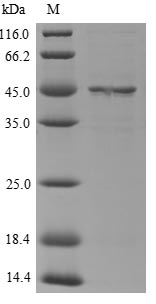The expression vector recombined with the recombinant DNA was transfected into the yeast cells for expression. The recombinant DNA resulted from the fusion of the gene coding for the 21-418aa of the mouse Serpina3n protein and the N-terminal 10xHis tag gene. The product was purified and isolated to get the recombinant mouse Serpina3n protein with N-terminal 10xHis tag. This recombinant Serpina3n protein's purity reaches up to 85%. Under SDS-PAGE condition, this recombinant Serpina3n protein showed a band with a molecular weight of about 45 kDa on the gel.
Serpina3n is a serine protease inhibitor and belongs serpin family which is the largest protease inhibitor family. Serpina3n is a recently identified novel serine protease inhibitor, α1-antichymotrypsin–like protein, from EB22, a murine chondrocytic cell line. This protein is expressed at high levels in brain, heart, liver, lung, spleen, testis and thymus, and at low levels in bone marrow, kidney and skeletal muscle. The function of this protein is still unknown. A study has reported that mice lacking SerpinA3N developed more neuropathic mechanical allodynia than wild-type (WT) mice, and exogenous delivery of SerpinA3N attenuated mechanical allodynia in WT mice. Additionally, another study found Serpina3n as the most female osteoblast–dominant gene. This study demonstrated that Serpina3n exerts a suppression of the osteoblast phenotypes such as Col1a1 expression and ALP activity in differentiated osteoblasts, which might partly explain sex differences of the osteoblast phenotypes in mice.






